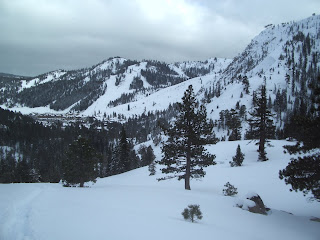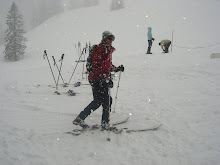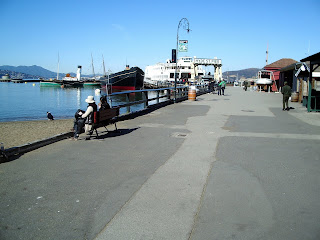The plan as it was when I left San Francisco at 5:30am was to park at Squaw Valley resort, then ski just outside the ski area boundary into the Granite Chief Wilderness that is adjacent to it. I got lucky with parking and entered a sort of trail at the far west end of the town. Following a previously broken trail, I forded a creek and found myself a few hundred feet above the town.

The pre-broken snowshoe trail ended nearly as quick as it started and soon I was breaking trail, spirits were high.
 I was jammin' to my shuffle, life was good. It is definitely easy to underestimate how much effort it is to break trail, even in about 2 feet of pow. I quickly determined the depth of the pow was too much to warrant a valid attempt on Granite Chief. So I made camp and woke up the next morning to a foot of new snow and the tent walls sagging very low. Here is a photo after I finished clearing it off. It was quite quaint being next to the tree, it was a swell wind break for the stove.
I was jammin' to my shuffle, life was good. It is definitely easy to underestimate how much effort it is to break trail, even in about 2 feet of pow. I quickly determined the depth of the pow was too much to warrant a valid attempt on Granite Chief. So I made camp and woke up the next morning to a foot of new snow and the tent walls sagging very low. Here is a photo after I finished clearing it off. It was quite quaint being next to the tree, it was a swell wind break for the stove.
Pretty much the entire day it snowed, sometimes big quarter-sized flakes. Boy did the snow get deep quick! By the time I left, I would wager to say it snowed 2-3 feet. I dug a test hole to the ground in a nearby drift, and started to build a cave, it may not look it, but this hole was 7-8 feet deep!
 After resolving that an attempt to go higher would be treacherous, I kept busy clearing off the snow from my shelter and enlarging it from the inside. Then all of a sudden the stove malfunctioned, repeatedly. Even after I had used it with no problems the whole trip. I don't know if it was the altitude (only about 7,000 ft.) or the cold or a broken piece in the pump mechanism itself. I took that sucker completely apart, cleaned it methodically and tried to coax it to life. It just would not maintain a hot flame (stove is a MSR Whisperlite Internationale). Since there was no real feasible way to melt snow for water or boil for tea, it was game over.
After resolving that an attempt to go higher would be treacherous, I kept busy clearing off the snow from my shelter and enlarging it from the inside. Then all of a sudden the stove malfunctioned, repeatedly. Even after I had used it with no problems the whole trip. I don't know if it was the altitude (only about 7,000 ft.) or the cold or a broken piece in the pump mechanism itself. I took that sucker completely apart, cleaned it methodically and tried to coax it to life. It just would not maintain a hot flame (stove is a MSR Whisperlite Internationale). Since there was no real feasible way to melt snow for water or boil for tea, it was game over.I started to leave at about 5:30-6:00. I did not get back to the car until 9:30, it took more than 3 hours to cover about 2 miles and it was a serious task. The combination of fresh, fluffy pow and me with my heavy rucksack on skis did not grant me the proper flotation I needed. Each step brought me forward and down, to practically my thighs and waist. It was an agonizingly slow process, I could only do 10 steps before having to catch my breath. Since the trail I blazed going out was gone, I had to break a new one, through 4+ feet of pow. Breaking trail can be a drag, if someone was there with me it would not have been so bad.
Many lessons were learned this trip. Make sure the stove works properly before leaving home- bring more fuel than you think you'll need, eliminate access weight, i.e. heavy food. If I had a lighter pack (and I thought it was pretty light- sub 30lbs), I think the going would have been much easier. Being solo into the backcountry in winter time is potentially dangerous, I should have stayed a bit closer to the car. Most important lesson: don't underestimate the snow!
However, I did have fun clearing off my car, she is nearly unmistakable. I was secretly hoping the giant block on my roof would last until the Bay Area, but warm central valley rain ruined it (-;













